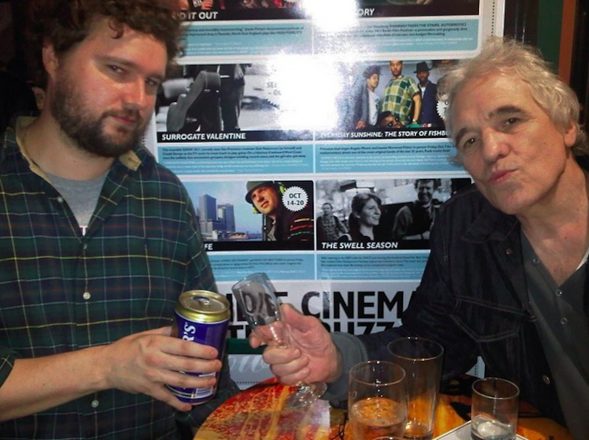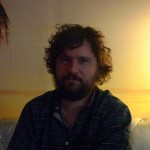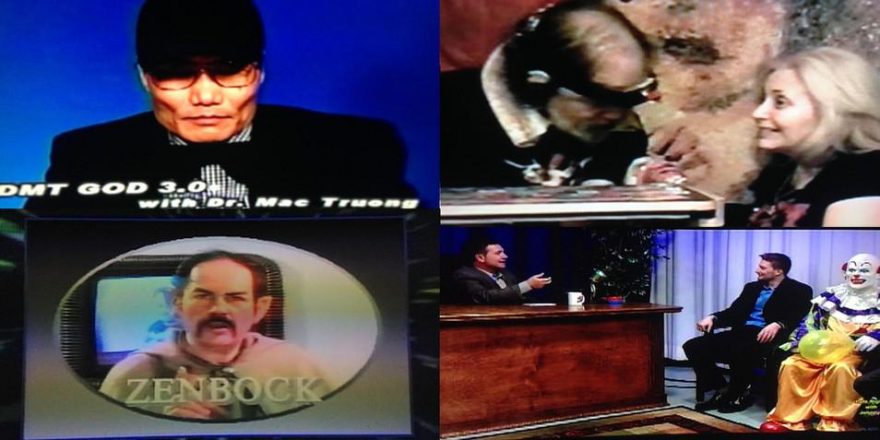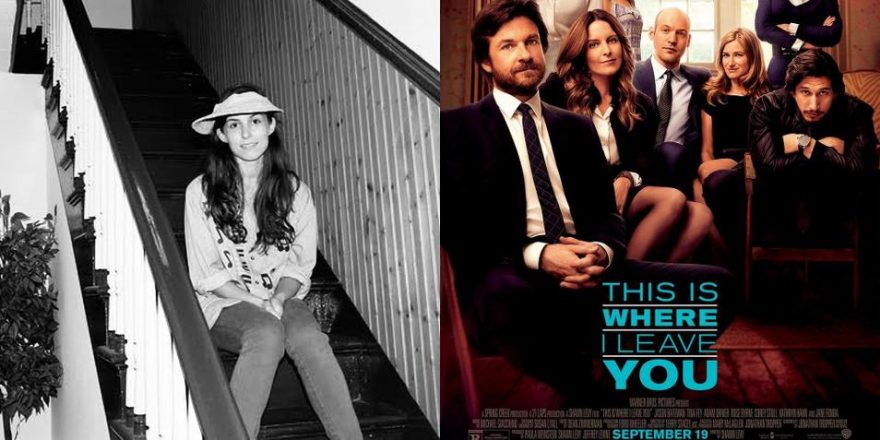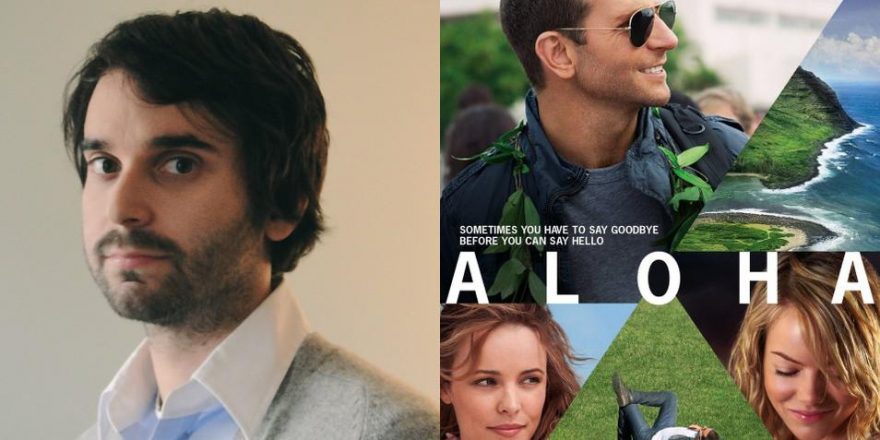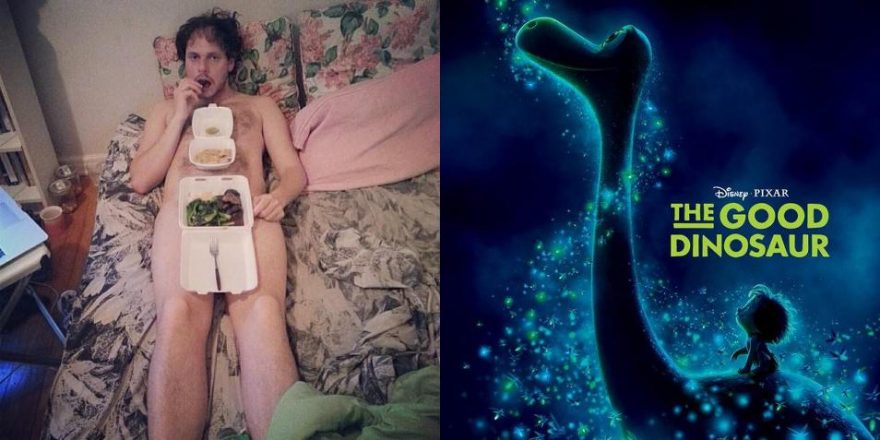In 2008, I set out to make my first feature film, Happy Life. Ronnie Bronstein’s Frownland had come out a year earlier and something was brewing in the city. His film was shot on grimy 16mm by Sean Price Williams and featured some of the least palatable characters of recent memory. It had an abrasive, electronic, score by Paul Grimstad and it was the first release by Factory 25. I knew Sean, as we both worked at Kim’s Video on St. Marks, and knew that he was a “cinematographer,” but I’d never really seen anything he’d shot before that. He’d do cool odd jobs like shooting Willi Ninja at the Tunnel or filming bizarro zero-budget underground features for the fashion casting director Ned Ambler. We were friends, but I was clueless as to how savage a D.P. he was. It was like a secret life.
Then Frownland dropped. The effect it had was gigantic. The New York City indie scene from the late nineties through 2007ish was largely a no man’s land of post-New York Underground Film Festival MNN-esque transgression; Nick Zedd, Reverend Jen, Todd Verow, etc. These films would maybe play for one night at Anthology and wind up in the shelves of Two Boots or Kim’s in the “Indie,” “Experimental” or “Queer” sections. The other “indie” films were more Sundance-style award winners, with budgets closer to the low millions than low thousands, mostly shot on 35mm. The success of Frownland, first at SXSW and then theatrically in N.Y.C., was an indicator that there could be a market for nasty, barebones work made with your friends! Not that making independent movies with your friends on nights and weekends was a new concept, but a new iteration of it was forming.
At the same time, consumer video had drastically improved. Joe Swanberg started making what would previously have been considered home videos in the suburbs of Chicago. They were sexually explicit, used affordable equipment, and featured young, hipster non-actors, for the most part. There were no scripts and lots of fucking. This style of filmmaking became what was infamously known as “mumblecore.” The classic Velvet Underground lore is that everyone who saw them in concert went on to start a band. With mumblecore, everyone that saw one of these movies went, “Maybe I can’t make a ‘real’ movie. But, damn, I could definitely do that!” The goalposts were shifting. I was excited. I couldn’t do any worse than that! Or so I thought.
I quit Kim’s to take a job as Abel Ferrara’s assistant on his documentary Chelsea on the Rocks. While we were running around the Chelsea Hotel, in full chaos mode, I started telling Abel the idea for a film I wanted to make. It was about an out-of-touch guy who owns an all-techno record store in the East Village. As his business dwindles, and the culture shifts away from his passion, he decides to throw an ill-advised rave to save the store. Abel said he’d executive produce it, but that I shouldn’t wait for anyone to magically come in to “greenlight” it. I should scrape together whatever money was already available and shoot it all as close to my apartment as possible! You can’t say no to that, so we were off to the races.
Sean and I decided to shoot on the Sony PD150. At a moment when everyone was jizzing their pants over the Red camera, or the latest prosumer HD, we went with a recently out-of-date SD format. The idea was that the unfashionable look of the film would match the protagonist, who was struggling to stay culturally relevant. I cast mostly friends. Our lead was an up-and-coming stand-up comedian, Tom McCaffrey. Kate Lyn Sheil and Alex Ross Perry, who had also both worked at Kim’s Video, and whose careers were just starting, had bit parts. And, most bizarrely, we had a cameo from MTV alternative VJ Matt Pinfield, as a junky selling off his house music record collection. We shot all over the Lower East Side in a frantic two-week production. My girlfriend at the time, Rachel Fernandes, and a classmate from NYU, Spencer Kiernan, produced it.
Upon completion, I was ready for the big time. We sent it off to Cannes, Sundance, Venice, all the key places. It had Abel’s name on it (which we put in absurdly huge letters on the poster), a crazy visual style, and featured a bunch of emerging talents. I was certain that in no time we’d all be getting blasted on a yacht in France with Leo and co. No response! We decided to maybe take it down a notch and aim for festivals that had familiar sounding names, even if we didn’t know anything about them; Telluride, Locarno, that type of shit. Nothing. We figured at the very least our friends who run some smaller, regional, fests would show it out of charity. Nope. In January 2011 Abel had a retrospective of his “21st Century” work at Anthology Film Archives and he strong-armed them into screening Happy Life as a sidebar. We premiered it in the big upstairs theater there on a snowy night. It completely sold out and everyone of note showed up. It was a blast. There was a one-off screening of it at the 92Y in Tribeca immediately after. I assumed that was the end of the road for us. No festivals would play it, so obviously no distributor would touch it, and subsequently no theater would run it. That was the last stop. We got one review. It was from some pretentious dork’s blog saying the movie sucked, it looked like shit, and that we should throw in the towel. I didn’t show it to anyone who worked on the film and hoped they weren’t Googling it.
I didn’t know Sophia Takal that well at the time. She was an actor, as was her boyfriend Larry Levine. They lived with Kate Lyn Shiel in Greenpoint. Larry had just directed his first feature, Gabi on the Roof in July, and Sophia was about to direct her first one, Green, starring Kate. Sophia was at the Happy Life screening at Anthology and sent me a message saying how much she liked it and that a friend of hers, Aaron Hillis, had recently opened a movie theater in Dumbo and would it be cool if she passed along a DVD of it to him? I said “Sure,” thinking nothing of it. Aaron wrote to me right away and asked if I wanted to do a weeklong run of the film. I was baffled but cautiously optimistic.
To describe reRun as unorthodox would be an understatement. It was tucked away in the back room of a “gastropub” in Dumbo. The vibe was a cross between finance bro and foodie. It was heavy on the “mixology” and experimental “small bites.” There would always be odd private events in the shadows. I remember peeping in a door one time and spotting a live painting class, complete with a nude model, for what appeared to be some afterwork team-building exercise. The theater was its own experience. There were 60 makeshift car seats and a 12-foot screen that only projected DVDs and Blu-rays. On an average night, there would only be a few people crashed out on the refurbished seats. There was usually a straggler or two from the bar, maybe a die-hard cinephile, and a friend or two of the filmmaker. There wasn’t exactly foot traffic out there.
Alex Ross Perry’s first feature, Impolex, shot by Sean and starring Kate, opened there a couple months before Happy Life. I recently asked Alex how he remembered the place. He described it as “so overtly horrible and unpleasant that to actually confront the realities of it meant the bad always fought hard against the good. It is nearly impossible to reconcile the fact that a mere decade ago, screening once a day in a retrofitted room with sub-consumer grade technical qualities, nothing to sit on but pilfered two-seaters removed from minivans and stinking of congealed duck-fat popcorn was enough to get your 75-minute movie reviewed in The New York Times, Village Voice, and so on.” Sean added, “reRun was a part of that very brief window where we were doing things while feeling like we were doing nothing. Our greatest achievement would be getting a Gotham nomination for Best Film Not Playing at a Theater Near You.” These two comments get at the crux of the matter – how could a place so shabby and unspectacular also be a breeding ground for a scene, was it even a scene, and how the hell did these tiny movies get reviewed in The New Yorker and The New York Times anyway?
My movie, that I had pretty much given up on, was finally opening theatrically. Granted, in a tiny room with hubcaps glued to the bar and playing on a Blu-ray, with dudes in jumpsuits with handlebar mustaches serving up ground beef-stuffed pretzels. I didn’t know what to expect. Early that Friday, I was at a deli with Abel in Little Italy and The New York Times had just been delivered. He picked up the paper, opened it to the Arts and Leisure section and there it was: a review of Happy Life. In a dramatic voice, he read it out loud in the middle of the store for everyone to hear, “The direction is woozy or absent. The movie’s dreadful interior lighting might be passed off as atmospheric or a victim of financing, but it mainly makes for difficult viewing. Still, the film advances the ‘let’s put on a show’ genre into a grim and hopeless direction, just right for hard times. In different hands Happy Life might become a decent movie.” My first thought was, “Ouch, that sucks!” My second thought was, “Damn, I can’t believe they actually reviewed it!” My third thought was, “That review sucks so hard, it’s almost sick!”
And the reviews kept rolling in. It somehow got an amazing Variety review. Got a great one from Slant. Got a D in The AV Club. Nick Pinkerton wrote about it in The Village Voice. I was hyped that it was somehow now a “real” movie. That these films could get hardcore press just from playing on a tiny screen on Blu-ray blew my mind. This is back when a lot of papers were obligated to review all films that received a week run in the city. I wound up getting a nicer review from The New York Times for my second film, Hellaware, when it played at Cinema Village. At some point, not long after that, many of these papers eliminated the policy of reviewing everything. My third feature, Jobe’z World, didn’t get a review from the Times. And it doesn’t look promising that my new movie, Project Space 13, will either. While that policy was great, what was more spectacular was that Hillis was able to program such distinct, and often surprising, films. Those two factors led to all sorts of microbudget work getting unprecedented exposure.
I first became acquainted with my good friend Eugene Kotlyarenko at reRun. His first feature, 0s & 1s, opened there a few months after Happy Life. His recollection was similar to mine. “It was really amazing to have my first feature play in a theater in New York for a week! To have it open on a Friday, to have random people purchase tickets, the whole shebang. I remember standing outside the theater trying to convince the Humans of Dumbo to come in and watch this weird lil computer flick. It was where I first met one of my greatest collaborators, Gene McHugh, and a bunch of other artists I only knew from the internet. There was a really nice Q&A with Brandon Harris that flattered my 24-year-old ego, and it helped get my immigrant parents off my back for three months, before they resumed their endless badgering about pursuing a career in law. Aaron’s connections as a critic also meant reRun films had a shot at a New York Times review, and boy did we get a good one: “0s & 1s is the Ultimate See-More-Than-Once-Movie.” I thought the high praise meant we would turn this into the first week of many, plus other engagements around the country. The naïve flicker of film glory still burned bright within me. But it wasn’t meant to be and we didn’t screen the film anywhere for a long time after that.” Like 0’s and 1s, Happy Life wouldn’t play again for many years either.
Our premiere has largely faded to memory. I think we filled most of the minivan seats. A lot of the cast and crew were there. Josh Safdie came and helped give the film a real boost over the years. I was certain Abel wouldn’t come, considering I’d never seen him leave downtown Manhattan. Even though I’d promised Aaron he would show, it seemed unlikely. But he somehow made it to the foreign lands of Dumbo. I chugged a bunch of those large cans of Foster’s, which struck me as a weird drink to serve at a theater. reRun was also the first theater I can think of in New York to serve beer. Abel was impressed with that and wondered why every theater wasn’t doing that. Soon, they were!
I couldn’t find a definitive list online of all the movies that played at reRun, but so much sticks out. It felt like there was a Factory 25 movie opening every other week. One of my fondest memories was Robert Greene’s Fake it So Real, where all these filmmakers made ridiculous promos and the screening was full of us hamming it up. I’m pretty sure Kate Sheil starred in half the movies that ever played there. Larry and Sophia’s movies were early “hits” there. It’s where I linked up with so many future collaborators. Zach Clark, who edited Jobe’z World, was always screening stuff. Stephen Gurewitz, who cut Project Space 13 and is one of my main homies, premiered his first feature, Marvin, Seth, and Stanley, there. The Safdies’ deep-cut Buttons played for a week. Lena Dunham and Greta Gerwig would pop up in movies all the time. There was an early Tiny Furniture screening there. Nathan Silver, Dustin Guy Defa, Kentucker Audley, Onur Tukel all had early films play there. But no one had more than Joe Swanberg. He’d sometimes have multiple openings a month. And between Matt Grady releasing them and The New Yorker’s Richard Brody fawning over them, it felt like an industrial process that could go on forever. Even if only a few people were showing up.
Alex wrote me, “Joe Swanberg once told me that people would look back on this venue with the same reverence as CBGB’s. I doubt that even more today than I did when he said it during one of our pitifully attended screenings. The question was often, ‘Will anybody show up?’ But, crucially, for the years of reRun’s existence, it was home base to a small and basically feeble scene. If journalists and critics found comfort in analyzing the so-called “NY indie microbudget boom” of the early 2010s, they did so from the program of this space. There was a scene, there was this theater – then there was no theater, and then there was no scene. Some people got to graduate to the ‘real’ theaters that reRun existed in the shadow of. Others stopped making movies altogether.”
Offering a somewhat brighter take on things, Sophia Takal told me, “When I think about reRun, I think about a space that brought together so many adventurous filmmakers. I think about all the energy and enthusiasm we had for our tiny, weird movies that had no chance of playing anywhere else. I think about all the aspirations (delusions?) I had about what playing at reRun might mean for my future. Little did I know, when that era was over, when I had moved forward in my career, made movies with bigger budgets that played in bigger theaters (none of which had car seats), I would look back at that time and space as one of the most creatively thrilling times of my life, when I was surrounded by a community of bold, unique artists who believed in the power of film. I miss being 25, I miss making movies for $900, I miss reRun.”
reRun closed in 2014. Happy Life wouldn’t publicly screen again until 2019, a full eight years after our opening there. This time it played at Spectacle, the new microcinema on the block, as part of a retrospective of my work. It’s a lot like reRun, minus the hubcaps, stuffed focaccia, and guaranteed New York Times coverage. It’s volunteer-run, with primo programming, and is one of my favorite venues. But it’s also not a “scene” in the way reRun was, which could only have existed in that specific moment. It’s its own scene. Anyway, I expected maybe four people to show up there, but it wound up selling out. (Granted, it’s tiny as fuck.) What most excited me, though, was seeing younger people in the audience who appeared to genuinely enjoy it and had a nostalgia for that time period – which surprised me, as I hadn’t ever thought about it, one way or another. I guess I mostly thought of that era as pretty wack. I got one of my all-time favorite reviews from the Spectacle screening on letterboxd: “A guy in the seat next to me was doing poppers the whole time and he told me after that the movie inspired him to call his old drug dealers.”
A year later, I started getting DMs from an anonymous Instagram account called Ioncellectuals. They kept asking for a link to Happy Life, as it wasn’t online anywhere. I said, “Fuck it,” and sent a Vimeo link over. I guess it was watched on Discord and people enjoyed it. I started getting more and more notifications about it. Sean texted me in the middle of the night at the Zola premiere that a group of young kids were all hyped up, telling him how much they like Happy Life. Pretty sure that was a first!
A year or so into the pandemic, Abel rolled back into town to premiere his new documentary, The Projectionist. Instead of a traditional week-long run, he decided to throw a party. He played some shows, screened a bunch of his older work, some cult classics, and some stuff from collaborators. He world premiered Stephen Gurewitz’s Honky Kong. He screened Happy Life. And he played Sean’s rarely seen 2011 directorial debut, Eyes Find Eyes. Watching those two on the big screen sent me spiraling off, trying to make sense of, or even remember, 2011. Eugene’s 0s & 1s played to a full house at the Roxy right after. 2011 fever was in the air.
When I look back to that moment of NYC indie filmmaking, one of the first things that comes to mind is the reRun Theater. I’m surprised by how forgotten it has become. I’m morbidly curious, somewhat scared, and also enthused to delve back into that period.
My new feature, Project Space 13, opens at the Roxy in Tribeca tonight. Like Happy Life, it played at zero festivals. It cost around the same amount to make and will probably get even fewer reviews. I’m honored that no one will have to pay $35 to see it and endure an AT&T or American Express commercial before it. Happy Life also screens tonight. It’s even on a marquee for the first time.


